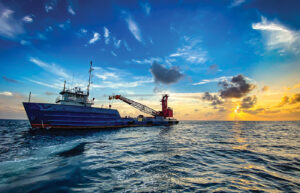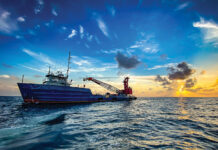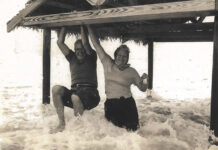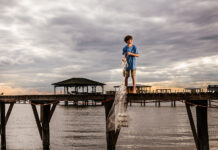
Photos by Matthew Coughlin • Photo above by Alex Fogg
“All right,” Captain Stewart Walter speaks into his radio, instructing his crew. “Cast off that last port stern line; let’s get ‘er moving.” It’s pitch black on the Intercoastal Waterway (ICW), 11:30 at night, and there’s little to distinguish between where the sky ends and the water begins, as the boat named Maranatha II leaves her moorings behind in Orange Beach. The air is tinged with the smell of saltwater blended with diesel fumes from the twin Caterpillar 399 engines as the 1200 horsepower motors begin to move the vessel to its destination, roughly five hours east. The bow thruster helps center the vessel to the middle of the ICW and she’s underway, moving at eight knots.
The five-member crew (Captain Stewart Walter, Sammy Goff, Rick Rodriquez, Will Knodel and Kenneth Gooden) readied the boat earlier, provisioning the galley with food and water, topping off fuel tanks, checking oil levels and filling the 20,000-gallon freshwater tank. The captain and crew of the company called Walter Marine — also known as Reefmaker — are on their way to deploy their artificial reefs off the coast of Navarre.
Goff, the night captain, takes his place in the black leather chair inside the worn wooden-paneled wheelhouse and adjusts floodlights in the direction of the waterway. The Maranatha II passes under the toll-bridge, past the docks at The Wharf and the brightly lit Ferris wheel, adding a bit of surrealism to the balmy May night. As the vessel continues to motor along the waterway, the sole boat seen in the pitch darkness is a shrimper. Occasionally, a dolphin’s fin breaks the surface of the water just off the bow, but otherwise all is still. Around 1 a.m., most of the crew heads to bed to try and catch a few hours’ shuteye before arising at dawn for reef deployment. Goff, alone in the wheelhouse, stays awake during the long night’s cruise by listening to a variety of music — hard rock, R&B, old classic country. “We’re all rednecks on this boat,” he says, “and they don’t make country music like they used to.”
Around 5 a.m., Gooden, the ponytailed deckhand and cook, talks about what he does, while stirring scrambled eggs, frying bacon and keeping a close eye on the biscuits, making sure they don’t burn in the ancient Vulcan oven. “Will and I, we’re both ABS,” he says, referring to the classification known as Able-Bodied Seaman. “We’re training on the crane, and we do whatever they need us to do, like watch the wheelhouse or check the engines every hour.”
Gooden finishes cooking and leaves the food on the large stainless-steel surface of the stove for the crew to serve themselves when they arise, then goes to the wheelhouse to relieve Goff. A few minutes later, Goff comes down to the galley and makes himself a plate. He’s lanky, with pale green eyes and a vocabulary that’s the hallmark of a voracious reader. “I’ve been at this a long time,” he says of boats and cruising as he spoons some Golden Eagle syrup on a hot and golden-brown biscuit, “and I read a lot of books.” He talks books and authors as he finishes his breakfast, then heads off to bed.
Captain Walter comes down to the galley, ready to start his day. As he makes a plate, leaving enough for the remainder of his crew, he says, “It’s a very cohesive crew, and there’s a reason for that: Will’s been with me about 10 years, Kenneth, about six years, and Rick, the crane operator, has been with me for 20 years.” Walter himself has been on board for more than 22 years. “I’ve done it all, from being a deckhand to cooking and cleaning to operating the crane. I’ve learned every aspect of operating and running this vessel.”
Return to Port
The Maranatha II is tied to her moorings at Walter Marine on Canal Road in Orange Beach, within sight of the bustle of The Wharf.
Gooden comes down for breakfast while Walter heads to the wheelhouse, where he will be the remainder of the day. As the boat maneuvers into place to be ready for the initial reef deployment, the bow thruster roars to riotous life. Gooden smiles and says, “If you don’t get awakened by the smell of my bacon cooking, you’ll wake up from the sound of the bow thruster.”
From the wheelhouse, Walter sees the sun rising over the Gulf, painting the clouds a light pink and highlighting the schools of flying fish off the starboard bow. The boat is at the first deployment location and the DP (Dynamic Positioning) system is doing its job. Nodding to the control panel, he points to the DP system. “DP is like magic,” he says. “We’re in a permitted area [for reef deployment], held by Okaloosa County. Using the DP technology, we can get within 3 meters of where we’re supposed to drop [a reef].”
There’s a slight delay of a couple of hours before deployment begins. “We’re waiting for the Okaloosa County reef coordinator and the FWC,” Walter says, referring to the Florida Wildlife and Conservation officials, who funded the creation and deployment of these reefs as part of the BP oil spill settlement. “They’ll ride over the area with a scan to see if there are any natural formations, to make sure we don’t destroy the natural bottom.”
While waiting for the FWC crew to arrive, Walter Marine founder David Walter talks via radio from his office in Orange Beach. He explains, “Our reefs are made with a patented process. Ground Florida limestone riprap is perfect artificial reef material. It’s the perfect Ph, soft enough for marine animals to bore into. Every animal that can live on a [naturally occurring] reef can live on Florida limestone reefs.”
He says they first deployed an artificial reef in 1986. “Now, we are the largest reef creators in the entire country and have deployed more than 70,000 reefs.” Besides making public reefs, Walter says Reefmaker also creates private reefs and can incorporate people’s ashes into those, as a kind of memorial. “We do that all the time,” he says.
Captain Walter hears this part of the conversation and adds an anecdote: “Back around 2012, there was this young guy who loved to fish from the Gulf Shores State Park pier. When he died unexpectedly, his parents asked us to incorporate his ashes into a reef. We had them meet us at the pier one morning early, and we deployed his reef while they watched.”
He adds, “Reefs provide habitat for marine life of all kinds, from juvenile turtles to adult grouper and red snapper. With increased habitat comes a greater number of anglers wishing to see what they can catch, and divers and snorkelers curious to see what they can find swimming on and around a reef.”
Knodel, one of the deckhands, comes into the wheelhouse. He’s stocky with strong, muscular arms, solid as petrified rock. He points off the starboard bow to the water below. “See dolphins swimming there?” he asks, blue eyes twinkling. “They see the reefs and they think, ‘Oh, we’re getting a new restaurant.’”
Make it Work
Captain Sammy Goff in his usual spot behind the wheel of The Maranatha II. Photo by Matthew Coughlin
A reef being deployed in Mexico Beach. Photo by Carol Cox
Will Knodel deftly climbs a stack of reefs and attaches riggings for the crane. Photo by Matthew Coughlin
Around 8 a.m. a 26-foot boat named the Poop Deck comes alongside the steel-hulled, 165-foot Maranatha II. It’s Alex Fogg, who serves as the Okaloosa County’s chief of natural resources, with FWC representative Eli Myron. They have two more guys with them, one to drive the boat and the other to help visually document the reef deployment.
They radio in: “Drop back 100 feet,” Fogg tells the captain.
Walter repositions the boat and gets an okay from Fogg. Finally, they’re at the approved position. “Put ‘er down,” Walter instructs the crew via radio. “Let me know when it hits bottom.”
“One eight nine,” Knodel calls out the numerical identifier for the reef. Walter repeats. They drop the reef in a little more than 120 feet of water. During this day’s deployment, the captain and crane-operator stay in constant radio contact.
After they finish deploying the first reef, the next reef they drop is a grouper reef. “Grouper like reefs that are cavernous,” Walter says, explaining the reef’s shape.
“We have a float on there that releases the latch when the reef is on the bottom,” he explains. The hook is called a ‘Pelican Hook.’”
Walter explains how reef placement is determined. “The County determines placement but works with the Coast Guard, the Florida DEP [Department of Environmental Protection] and the Corps of Engineers. They don’t want the reef to be a hazard to navigation; they also want to ensure that reefs are deployed over an otherwise barren bottom.” He adds, “Alex also consults the shareholders or taxpayers to get their input as to reef placement. They requested certain reefs to be deployed; we bid on it and won. David puts the proposals together and I put the numbers together — what we can do for x amount of dollars. We own all our equipment, everything’s paid for, so we can bid competitively. We’ve developed good relationships with these people. They know we do a good job, we’re on time; that goes a long way, when you’ve built trust.”
In watching deckhands Knodel and Gooden climb up a pyramidal-shaped reef to hook the crane to it, Stewart adds, “This work is intense and requires patience and prolonged concentration: one slip can result in disaster.”
Walter speaks of the beginning of the Reefmaker company. “Dad [David Walter] was very focused on his bar and restaurant, then he thought that God wanted him to pursue this and expand upon it. I don’t think this ever happened where he said, ‘Oh, this is going to be my career,’ but it grew into that.”
He continues, while watching the crane operator in action. “In the last 15 years, he turned the reins over to me, and now he does the office stuff. We became partners two years ago. When I need him, he’s available. He still likes to do some of the office things, like work on proposals for new projects.”
Walter adds, “We need to try and achieve a fishery that’s sustainable. We naturally don’t have any red snapper here, but we’ve developed a whole ecosystem that wasn’t here before.
“I like doing a good job, knowing every reef is deployed accurately. I like being here with my boat family. I’m very able to hit the ‘now’ and be content.”
Some of the 36,000-pound Super Reefs have poles on top of them. “Those are FADs, or fish aggregating devices,” Walter says. “They attract fish that will attract pelagic fish. We call them Amberjack poles or reef donkey poles.” He presses a few buttons on the control panel; the air pressure coming off the pneumatic system makes a hissing, groaning sound.
Under the Sea
A Florida limestone pyramid after several years under the Gulf of Mexico, teeming with sea life. Photo by Carol Cox
The inside of a super reef in Mexico Beach, Florida. Photo by Carol Cox
Poseidon’s throne is made ready to deploy to south Walton County in the Underwater Museum of Art. Photo by Matthew Coughlin
By the time most of the reefs had been deployed, the relative lightness of the vessel challenges the crew to keep the Maranatha II on the deployment spots. The added uncertainty is always compounded by the seas: “We were told to expect 2 to 3-foot seas,” Gooden says as he prepares to connect the crane hook to the last pyramid. “We’ve got some six-footers, and that really challenges us, with the movement of the boat and working with the crane operator.”
A little after 1 p.m., all the reefs have been deployed to their assigned locations. The captain and his crew have covered an 8 1/2-mile area off the Florida coastline. It took a total of 42 grouper reefs, 20 super reefs and 194 Florida limestone-artificial reefs to complete this project. Satisfied with the completion of the deployment, the officials of the FWC say good-bye and head back to their office.
The father-and-son team of Walter Marine sees a kind of immortality in what they’re doing. “These reefs will last longer than we’ll be around,” the younger Walter says. “I mean, look at the Roman aqueducts; they’re made of concrete and they’re still here.”
The crew rinses off the crane, secures it to the deck and hoses off the empty deck (“This helps keep corrosion caused by salt water at bay,” explains Knodel). Then all but Goff and Rodriquez head to get a bit more sleep. Goff remains at the wheel, heading the vessel back to the ICW and Orange Beach. Rodriquez is watchman for now.
After his nap, Gooden makes a simple supper for the crew. He’s a meat-and-potatoes kind of cook, and, as Rodriquez says, “As long as I’m not the one cooking, I’m happy.”
As the Maranatha II motors down the ICW with night descending like a purplish-gray veil, the feeling aboard is almost exuberant, with crew members telling jokes and laughing, glad for another successful deployment.













